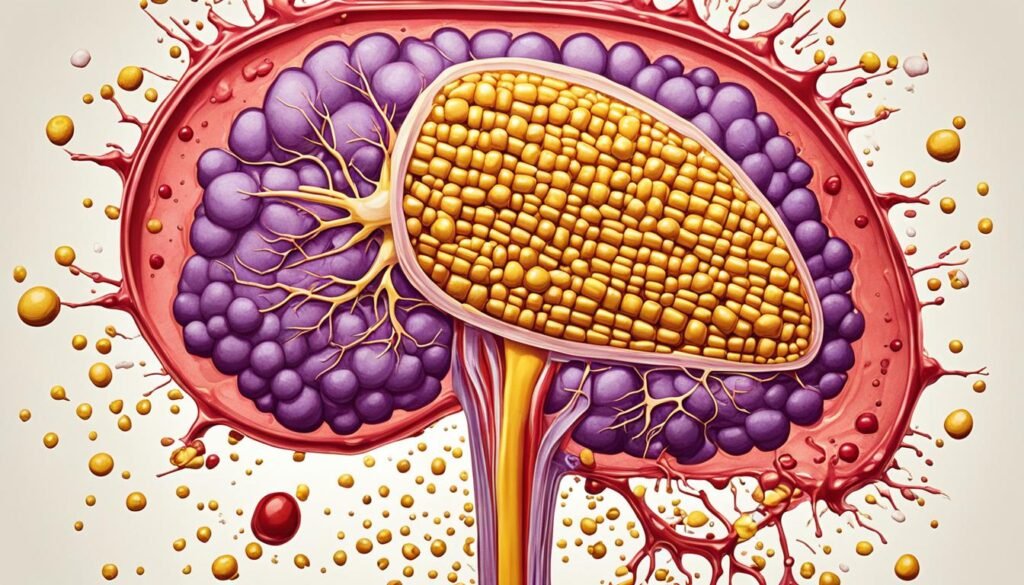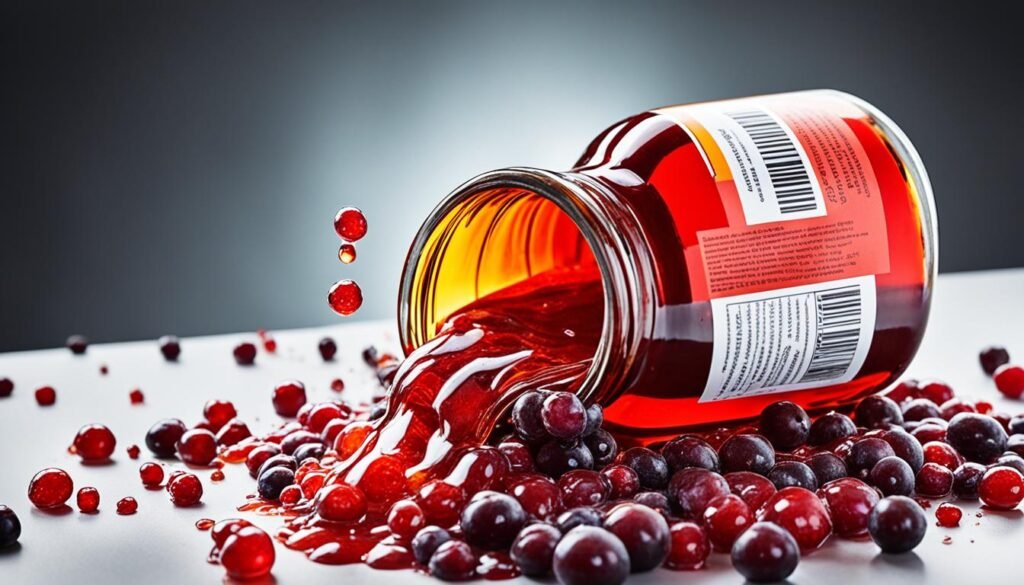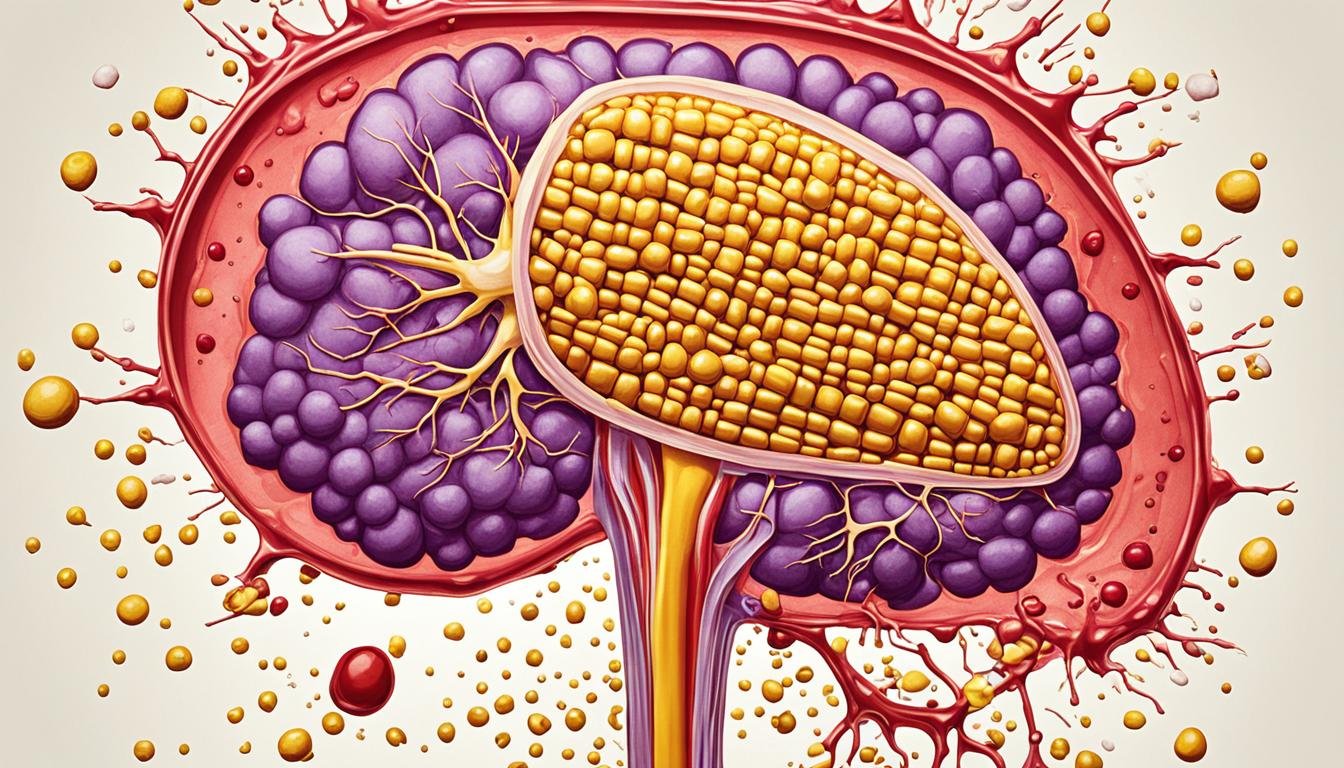High-fructose corn syrup (HFCS) is an artificial sugar from corn syrup. Many experts say HFCS and added sugar cause obesity today.1 They also link these sugars to diabetes and heart disease.1
HFCS and regular sugar have fructose and glucose. But, our bodies handle fructose and glucose differently. Too much fructose can cause many health issues.
Key Takeaways
- High-fructose corn syrup is an artificial sweetener linked to obesity, diabetes, and other serious health issues.
- The body metabolizes fructose differently than glucose, and excessive fructose consumption can lead to various health problems.
- Obesity rates have increased significantly in recent decades, in part due to the widespread use of HFCS and added sugars in processed foods.
- HFCS and other added sugars provide “empty” calories without essential nutrients, contributing to nutrient displacement and poor dietary quality.
- Limiting the consumption of HFCS and added sugars in favor of more natural, nutrient-dense sweeteners and whole foods can support overall health and reduce the risk of chronic diseases.
Understanding High-Fructose Corn Syrup
What is High-Fructose Corn Syrup?
High-fructose corn syrup (HFCS) is a sweetener made from corn. It varies in its fructose content; HFCS 90 is 90% fructose, HFCS 55 is 55% fructose, and HFCS 42 has 42% fructose.2 Many processed foods and drinks use it because it’s cheap and easy to find.
Composition and Production Process
HFCS 55 is the most common form. It’s a liquid with 24% water. Regular sugar, on the other hand, is dry and in granules.2 Making HFCS involves steps that turn corn starch into glucose, and then into fructose. The final product is much like table sugar.
Prevalence in Processed Foods
Between 1980 and 2000, more foods started using high-fructose corn syrup. But from then, its use is going down, maybe because artificial sweeteners are becoming more popular.2 Still, HFCS is found in a lot of foods and drinks, adding to the sugar we eat.3
The Fructose Connection
When we eat carbs, they turn into glucose, which our body quickly uses.2 But, fructose from high-fructose corn syrup (HFCS) and sugar acts differently. It changes into glucose or fat in the liver first. Then, our cells can get energy from it.2 This special way fructose works is why too much HFCS and sugar can harm our health.
Fructose Metabolism and Health Risks
The liver is key in handling fructose. Too much fructose can make the liver store fat. This leads to problems like fatty liver disease, insulin issues, obesity, and diabetes.2
Comparing Fructose to Glucose
Our cells use glucose quickly. Fructose, however, needs a change before cells can use it. This difference is important in knowing why too much fructose is bad for health.2 Both HFCS and sugar can harm health if we eat too much. Research shows they affect our health the same way when over-consumed.2
Not all fructose is bad, though. The trouble comes from too many added sugars in processed foods and drinks.2 Fruits have fructose, too. But since they come with other good nutrients and we usually don’t eat too much fruit all at once, it doesn’t cause the same problems.
Non-Alcoholic Fatty Liver Disease
Drinking too much high-fructose corn syrup (HFCS) and other sugars is bad for our livers. This can cause our livers to store more fats and lead to non-alcoholic fatty liver disease (NAFLD).4
The Role of Fructose in Liver Fat Accumulation
Drinks with fructose or HFCS make our livers store more fat than other drinks or milk. This extra fat can cause type 2 diabetes and other health issues.4 Mice that ate a lot of fructose had fatty livers and more liver tumors compared to those on a normal diet.4
Progression to Non-Alcoholic Steatohepatitis
NAFLD can get worse and cause liver inflammation, damage, and other serious issues. Mice on a high-fructose diet for a long time showed signs of liver troubles and more endotoxins in their blood.4 Fixing the mice’s gut barriers helped stop liver fat buildup. This shows a new approach to treating NAFLD.4

Obesity and Weight Gain
Many studies link too much high-fructose corn syrup (HFCS) and other sugars to obesity and weight gain.5 HFCS, which has fructose, doesn’t stop us from feeling hungry like glucose does. This can make us eat too much and get visceral fat around our organs.5 More HFCS and sugar being used means we eat more calories. This is big reason for weight gain and obesity.6
Fructose and Appetite Regulation
Fructose doesn’t help us feel full by releasing hormones like glucose does.5 So, we might eat more, adding visceral fat. This fat around our organs raises the risk of metabolic disorders.6
Visceral Fat Accumulation
Drinking fructose-sweetened drinks can add to visceral fat and lower insulin sensitivity.6 This visceral fat is bad and can lead to serious issues like type 2 diabetes and heart problems.
Increased Caloric Intake
HFCS and sugars in many foods and drinks now make us eat more calories.6 This overeating is a big part of the obesity problem today. It also causes many health risks.5
high-fructose corn syrup vs sugar
The debate about high-fructose corn syrup (HFCS) and sugar is ongoing. It’s vital to know how they are both alike and different.2
Similarities in Composition
HFCS and table sugar (sucrose) share a lot in common. They both have fructose and glucose. HFCS 55 has 55% fructose and 45% glucose, while table sugar has an even 50/50 mix.2 So, they are very similar in makeup.
Health Effects of Added Sugars
Too much HFCS and sugar can harm our health. They can lead to issues like insulin resistance, obesity, and diabetes. Study shows their impacts are alike when taken in the same amounts.2
But, overdoing any kind of added sugar is the real problem. Not just HFCS or table sugar. Natural sugars in fruits are better for us because they come with fiber, nutrients, and antioxidants.2
Dietary Guidelines and Recommendations
To stay healthy, it’s wise to eat less sugar. This means cutting down on both HFCS and regular sugar.7 The American Heart Association advises on the daily sugar limit. It’s between 6 to 9 teaspoons. This is lower than what most Americans take in, which is about 20 teaspoons.
Through learning about HFCS and sugar, plus following good diet advice, we can pick what’s best for our health.

Insulin Resistance and Diabetes
Eating lots of fructose or high-fructose corn syrup (HFCS) can make you insulin resistant. This means your body doesn’t react well to insulin.8 When this happens, it can lead to problems like metabolic syndrome and type 2 diabetes.8 High fructose levels in your diet make your blood sugar and insulin spike. This also raises your risk of these health issues over time.
Impaired Insulin Signaling
Your body processes fructose differently than glucose. So, having too much fructose can mess up how your insulin works.9 This might lead to insulin resistance. Then, your cells don’t react well to insulin, causing high blood sugar and more risk of type 2 diabetes.
Metabolic Syndrome and Type 2 Diabetes
A mix of insulin resistance, obesity, high cholesterol, and high blood pressure creates metabolic syndrome. This affects many in the U.S.8 Those with it are more likely to get type 2 diabetes. It’s a health issue where your body can’t manage blood sugar well.8 Too much fructose and HFCS can make these problems worse.

Inflammation and Other Diseases
Too much high-fructose corn syrup (HFCS) and added sugars cause more inflammation. They make harmful AGEs and raise uric acid levels.10 This might lead to gout, heart diseases, and other health issues.10 These effects could also raise the risk of getting some cancers.
Advanced Glycation End Products (AGEs)
Fructose metabolism, from HFCS or sugar, can make the body produce bad substances. These can cause inflammation and stress.5 The body may then build up AGEs, which help diseases grow. This includes heart and metabolic problems.5
Gout and Uric Acid Production
Having too much fructose, especially from HFCS, can raise uric acid levels.10 This is bad because it can cause gout. Gout is very painful and affects the joints.
Cardiovascular Diseases
HFCS and sugars are bad for our hearts. They can up the risk of heart problems.10 Drinking sugary drinks, with or without HFCS, makes this risk higher.10 They can also make us fat and cause problems with insulin and metabolism. These things add to the risk of heart diseases.10

Nutrient Density and Dietary Quality
High-fructose corn syrup (HFCS) and added sugars are called “empty” calories. They give energy but no nutrients.5 Eating a lot of HFCS and sugar can mean less healthy foods. This leads to getting fewer vitamins, minerals, and other good stuff.9 It makes diets less nutritious and causes health issues.
Empty Calories and Nutrient Displacement
HFCS and added sugars in processed foods are a big issue. They cause “nutrient displacement” in diets.9 Eating more HFCS and sugar means eating less healthy whole foods. This can lead to not getting enough important vitamins and minerals.
Too much HFCS and added sugars is bad. They add calories but not the good stuff we need. It makes us eat less of the natural, nutrient-rich foods we should be eating.5 This can cause problems like obesity, diabetes, and other chronic diseases.9
To have a better diet, we should cut back on HFCS and sugars. We should choose natural sweeteners and whole foods instead.5 Picking nutrient-rich foods improves our diet and health in the long run.
Conclusion
In recent years, many experts have pointed out that too much high-fructose corn syrup (HFCS) and added sugars can be bad for our health. They say these can cause obesity, diabetes, and other health problems.5 Eating too much HFCS and sugar is not good for your body. It can cause problems like a fatty liver, your body can stop using insulin the right way, and cause swelling inside you.5 To stay healthy and lower your chances of getting sick, try to eat less HFCS and other added sugars. It’s better to choose foods with natural sweetness and those that are whole.
Studies show that HFCS and sugar have much the same stuff in them. However, the health issues are with how much you eat, not where the sugar comes from.2 Choosing to eat less high-fructose corn syrup, sugar, and fake sweeteners can really help. This way, you make your diet better and stay healthier.
We always see new foods and drinks, but it’s important to know what’s good for us.52 Choosing to learn more and eat a balanced, healthy diet is key. This can help make a world where less people get diseases because they eat too much sugar.
FAQ
What is high-fructose corn syrup (HFCS)?
How does HFCS differ from regular sugar?
What are the health risks associated with HFCS and added sugars?
How does the body metabolize fructose differently from glucose?
How does HFCS contribute to non-alcoholic fatty liver disease?
Why is HFCS linked to weight gain and obesity?
What are the dietary guidelines for HFCS and added sugars?
How does HFCS and added sugar affect inflammation and other diseases?
How does HFCS and added sugar impact the overall nutritional quality of the diet?
Source Links
- https://www.ncbi.nlm.nih.gov/pmc/articles/PMC3649104/
- https://www.healthline.com/nutrition/high-fructose-corn-syrup-vs-sugar
- https://www.webmd.com/diet/what-to-know-about-high-fructose-corn-syrup
- https://www.nih.gov/news-events/nih-research-matters/how-high-fructose-intake-may-trigger-fatty-liver-disease
- https://www.ncbi.nlm.nih.gov/pmc/articles/PMC9551185/
- https://www.ncbi.nlm.nih.gov/pmc/articles/PMC5747444/
- https://www.popsci.com/high-fructose-corn-syrup-sugar/
- https://www.ncbi.nlm.nih.gov/pmc/articles/PMC552336/
- https://www.ncbi.nlm.nih.gov/pmc/articles/PMC5983097/
- https://www.ncbi.nlm.nih.gov/pmc/articles/PMC9471313/

